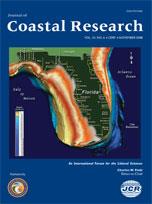Sediment cores (up to 6 m in length) from the bottom of the Blue Hole, a 125 m deep Pleistocene sinkhole located in the lagoon of Lighthouse Reef Atoll, Belize, consist of undisturbed, annually layered biogenic carbonate muds and silts with intercalated coarser grained storm beds. The sedimentation rate of the layered sections is 2.5 mm/y on average, and the long cores span the past 1500 years. Oxygen isotopes of laminated sediment provide a late Holocene climate proxy: A high-resolution δ18O time series traces the final Migration Period Pessimum, the Medieval Warm Period, the Little Ice Age, and the subsequent temperature rise. Carbon isotopes (δ13C) decrease up core and show the impacts of the decline of the Mayan culture and the Suess effect. Time series analyses of δ18O and δ13C content reveal 88-, 60-, 52-, and 32-year cyclicities, and suggest solar forcing. Storm event beds are most common during AD 650–850, around AD 1000, during AD 1200–1300, and AD 1450–1550. Major storm beds are rare during the past 500 years BP.
How to translate text using browser tools
1 November 2008
A 1500-Year Holocene Caribbean Climate Archive from the Blue Hole, Lighthouse Reef, Belize
Eberhard Gischler,
Eugene A. Shinn,
Wolfgang Oschmann,
Jens Fiebig,
Noreen A. Buster
ACCESS THE FULL ARTICLE
Belize
Blue Hole
carbonates
Climate
Holocene
isotopes





